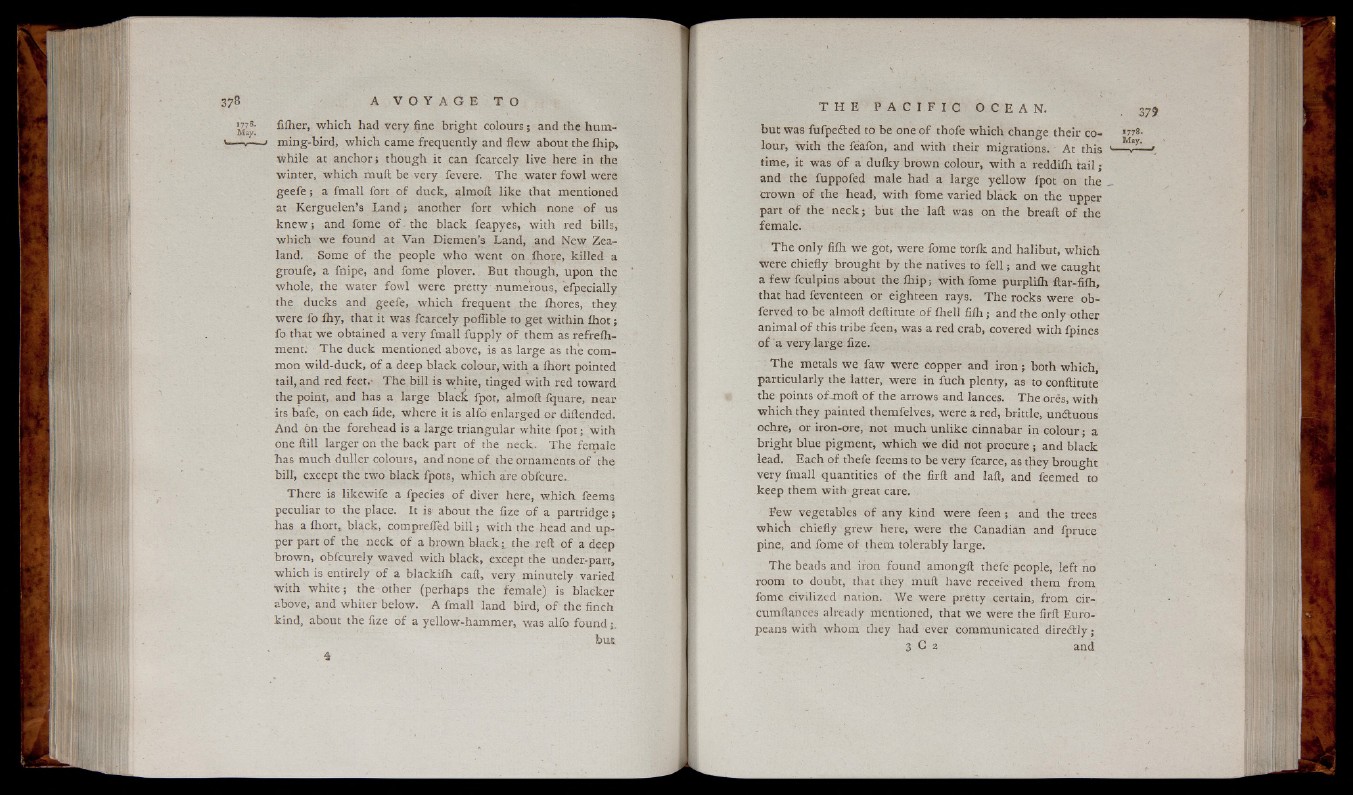
w 8- filher, which had ve ry fine b right co lou rs ; and the humv.—
*— > ming-bird, w h ich came frequently and flew about the Ihip,
w h ile at anchor; though it can fcarcely live here in the
winter, w hich muit be very fevere. T h e water fow l were
g e e f e ; a fmall fort o f duck, almofl; lik e that mentioned
at Kerguelen’s L a n d ; another fort w hich none o f us
k n ew ; and fome o f . the bla ck feapyes, w ith red bills,
w h ich w e found at Van Diemen’s Land, and New Zealand.
Some o f the people who wen t on ihore, k illed a
groufe, a fnipe, and fome plover. But though, upon the
w hole, the water fowl were pretty numerous, efpecially
the ducks and geefe, w h ich frequent the fhores, the y
w ere fo Ihy, that it was fcarcely polfible to ge t within f lio t ;
fo that w e obtained a ve ry fmall fu p p ly o f them as refreih-
ment: T h e duck mentioned above, is as large as the common
wild -duck, o f a deep black colour, w ith a ihort pointed
tail, and red feet.- T h e bill is white, tinged with red toward
the point, and has a large black fpot, almofl: fquare, near
its bafe, on each fide, where it is alfo enlarged or diftended.
And on the forehead is a large triangular white fpot; with
one ftill larger on the ba ck part o f the neck. T he female
has much duller colours, and none o f the ornaments o f the
bill, except the two black fpots, w hich are obfcure.
The re is likewife a fpecies o f diver here, which, feems
peculiar to the place. It is' about the fize o f a p a r tr id g e ;
has a ihort, black, comprefied b i l l ; With the head and upper
part o f the n eck o f a brown b l a c k t h e reft o f a deep
brown, obfcurely waved with black, except the under-part,
w hich is entirely o f a b la ck iih caft, very minutely varied
w ith w h ite ; the other (perhaps the female) is blacker
above, and whiter below. A fmall land bird, o f the finch
kind, about the fize o f a yellow-hammer, was alfo found j.
b u t
but was fufpetfled to be one o f thofe which change their co- *77*.
lour, with the feafon, and with their migrations. At this ' U7 ' ■»
time, it was o f a d u ik y brown colour, w ith a reddiih t a i l ;
and the fuppofed male had a la rge y e llow fpot on the _
Crown o f the head, w ith fome varied b lack on the upper
part o f the n e c k ; bu t the laft was on the breaft o f the
female.
T h e only fifh w e got, were fome torik and halibut, w h ich
w ere chiefly brought b y the natives to f e l l ; and w e caught
a few fculpins about the ih ip ; w ith fome purpliih ftar-fifh,
that had feventeen or eighteen rays. T h e rocks were ob-
ferved to be almofl deftitute o f ihe ll filh ; and the on ly other
animal o f this tribe feen, was a red crab, covered with fpines
o f a ve ry la rge fize.
T h e metals we faw were copper and i r o n ; both which,
particularly the latter, were in fuch plenty, as to conftitute
the points ofijnoft o f the arrows and lances. T h e ores, with
w hich they painted themfelves, were a red, brittle, uncluous
ochre, or iron-ore, not much u n lik e cinnabar in c o lo u r ; a
bright blue pigment, w h ich we did not p ro cu re ; and bla ck
lead. Each o f thefe feems to be ve ry fcarce, as they brought
ve ry fmall quantities o f the firft and laft, and feemed to
k e e p them with great care.
Few vegetables o f any kin d were fe e n ; and the trees
w hich chiefly g rew here, were the Canadian and fpruce
pine, and fome o f them tolerably la rge .
T he beads and iron found amongft thefe people, left no
room to doubt, that they muft have received them from
fome civilized nation. We were pretty certain, from cir-
cumftances already mentioned, that we were the firft Europeans
with whom they had ever communicated d i r e d ly ;
3 C 2 and